Sharp CP-BA150, CD-BA150 User Manual

MODEL
MINI COMPONENT SYSTEM |
CD-BA150 |
|
|
OPERATION MANUAL |
|
Thank you for purchasing this SHARP product.
To obtain the best performance from this product, please read this manual carefully.
It will guide you in operating your SHARP product.
CD-BA150 Mini Component System consisting of CD-BA150 (main unit) and CP-BA150 (speaker system).
The lightning flash with arrowhead symbol, within an equilateral triangle, is intended to alert the user to the presence of uninsulated "dangerous voltage" within the product's enclosure that may be of sufficient magnitude to constitute a risk of electric shock to persons.
C A U T I O N
R I S K O F E L E C T R I C S H O C K
D O N O T O P E N
CAUTION: TO REDUCE THE RISK OF ELECTRIC SHOCK, DO NOT REMOVE COVER (OR BACK).
NO USER-SERVICEABLE PARTS INSIDE. REFER SERVICING TO QUALIFIED SERVICE PERSONNEL.
The exclamation point within an equilateral triangle is intended to alert the user to the presence of important operating and maintenance (servicing) instructions in the literature accompanying the appliance.
Caution - use of controls or adjustments or performance of procedures other than those specified herein may result in hazardous radiation exposure.
Note:
This equipment has been tested and found to comply with the limits for a Class B digital device, pursuant to Part 15 of the FCC Rules.
These limits are designed to provide reasonable protection against harmful interference in a residential installation.
This equipment generates, uses, and can radiate radio frequency energy and, if not installed and used in accordance with the instructions, may cause harmful interference to radio communications.
However, there is no guarantee that interference will not occur in a particular installation. If this equipment does cause harmful interference to radio or television reception, which can be determined by turning the equipment off and on, the user is encouraged to try to correct the interference by one or more of the following measures:
●Reorient or relocate the receiving antenna.
●Increase the separation between the equipment and receiver.
●Connect the equipment into an outlet on a circuit different from that to which the receiver is connected.
●Consult the dealer or an experienced radio/TV technician for help.
WARNING
WARNING: TO REDUCE THE RISK OF FIRE OR ELECTRIC SHOCK, DO NOT EXPOSE THIS APPLIANCE TO RAIN OR MOISTURE.
Note:
●It is the intent of Sharp that this product be used in full compliance with the copyright laws of the United States and that prior permission be obtained from copyright owners whenever necessary.
FOR YOUR RECORDS
For your assistance in reporting this unit in case of loss or theft, please record below the model number and serial number which are located on the rear of the unit.
Please retain this information.
Model number ______________________________
Serial number ______________________________
Date of purchase____________________________
Place of purchase ___________________________
FCC Regulations state that any unauthorized changes or modifications to this equipment not expressly approved by the manufacturer could void the user's authority to operate this equipment.
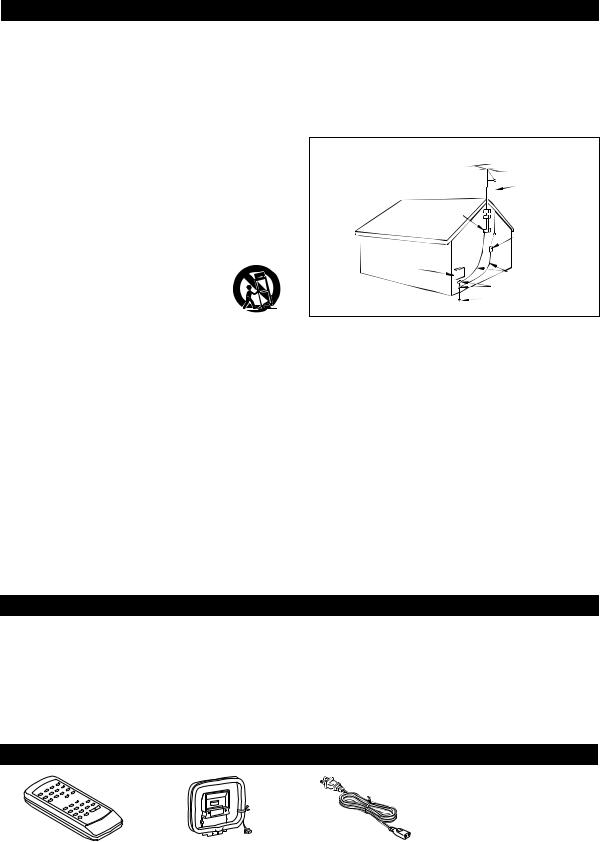
IMPORTANT SAFEGUARDS
CAUTION
All the safety and operating instructions should be read before the appliance is operated, and should be retained for future reference.
Electrical energy can perform many useful functions. This unit has been engineered and manufactured to assure your personal safety. Improper use can result in potential electrical shock or fire hazards. In order not to defeat the safeguards, observe the following basic rules for its installation, use and servicing.
1Heed Warnings - All warnings on the appliance and in the operating instructions should be adhered to.
2Follow Instructions - All operating and use instructions should be followed.
3Water and Moisture - The appliance should not be used near water - for example, near a bathtub, washbowl, kitchen sink, laundry tub, in a wet basement, or near a swimming pool, etc.
4Carts and Stands - The appliance should be used only with a cart or stand that is recommended by the manufacturer.
∙An appliance and cart combination should be moved with care.
Quick stops, excessive force, and uneven surfaces may cause the appliance and cart combination to overturn.
5Wall or Ceiling Mounting - The appliance should be mounted to a wall or ceiling only as recommended by the manufacturer.
6Ventilation - The appliance should be situated so that its location or position does not interfere with its proper ventilation. For example, the appliance should not be situated on a bed, sofa, rug, or similar surface that may block the ventilation openings; or, placed in a built-in installation, such as a bookcase or cabinet that may impede the flow of air through the ventilation openings.
7Heat - The appliance should be situated away from heat sources such as radiators, heat registers, stoves, or other appliances (including amplifiers) that produce heat.
8Power Sources - The appliance should be connected to a power supply only of the type described in the operating instructions or as marked on the appliance.
9Power-Cord Protection - Power-supply cords should be routed so that they are not likely to be walked on or pinched by items placed upon or against them, paying particular attention to cords at plugs, convenience receptacles, and the point where they exit from the appliance.
10Do not use liquid cleaners or aerosol cleaners. Use a damp cloth for cleaning.
11Power Lines - An outdoor antenna should be located away from power lines.
12Outdoor Antenna Grounding - If an outside antenna is connected to the receiver, be sure the antenna system is grounded so as to provide some protection against voltage surges and built-up static charges. Section 810 of the National Electrical Code, ANSI/NFPA No. 70-1984, provides information with respect to proper grounding of the mast and supporting structure, grounding of the lead-in wire to an antenna discharge unit, size of grounding conductors, location of antenna-discharge unit, connection to grounding electrodes, and requirements for the grounding electrode.
EXAMPLE OF ANTENNA GROUNDING AS PER
NATIONAL ELECTRICAL CODE
E L E C T R I C
S E R V I C E
EQUIPMENT
NEC - NATIONAL ELECTRICAL CODE S2898A
ANTENNA LEAD
IN WIRE
GROUND
CLAMP
ANTENNA DISCHARGE UNIT
(NEC SECTION 810-20)
GROUNDING CONDUCTORS (NEC SECTION 810-21)
GROUND CLAMPS
POWER SERVICE GROUNDING ELECTRODE SYSTEM
(NEC ART 250, PART H)
13Nonuse Periods - The power cord of the appliance should be unplugged from the outlet when left unused for a long period of time.
14Object and Liquid Entry - Care should be taken so that objects do not fall and liquids are not spilled into the enclosure through openings.
15Damage Requiring Service - The appliance should be serviced by qualified service personnel when:
AThe power-supply cord or the plug has been damaged; or
BObjects have fallen, or liquid has been spilled into the appliance; or
CThe appliance has been exposed to rain; or
DThe appliance does not appear to operate normally or exhibits a marked change in performance; or
EThe appliance has been dropped, or the enclosure damaged. 16 Servicing - The user should not attempt to service the appliance
beyond that described in the operating instructions. All other servicing should be referred to qualified service personnel.
17Grounding or Polarization - Precautions should be taken so that the grounding or polarization means of an appliance is not defeated.
CONTENTS
Page ACCESSORIES . . . . . . . . . . . . . . . . . . . . . . . . . . . . . . . . . .1 PRECAUTIONS . . . . . . . . . . . . . . . . . . . . . . . . . . . . . . . . . .2 PREPARATION FOR USE . . . . . . . . . . . . . . . . . . . . . . . 3-5 SETTING THE CLOCK . . . . . . . . . . . . . . . . . . . . . . . . . . . .6 SOUND CONTROL . . . . . . . . . . . . . . . . . . . . . . . . . . . . . . .7 COMPACT DISC OPERATION . . . . . . . . . . . . . . . . . . . 8-10 RADIO OPERATION . . . . . . . . . . . . . . . . . . . . . . . . . . 11-12 CASSETTE OPERATION . . . . . . . . . . . . . . . . . . . . . . . . .12
Page RECORDING . . . . . . . . . . . . . . . . . . . . . . . . . . . . . . . . . . . 13 HOW TO USE THE BUILT-IN TIMER . . . . . . . . . . . . . . . 14 USING EXTERNAL UNITS . . . . . . . . . . . . . . . . . . . . . . . . 15 RESETTING THE MICROCOMPUTER . . . . . . . . . . . . . . 15 TRANSPORTING THE UNIT . . . . . . . . . . . . . . . . . . . . . . 15 MAINTENANCE . . . . . . . . . . . . . . . . . . . . . . . . . . . . . . . . . 16 SPECIFICATIONS . . . . . . . . . . . . . . . . . . . . . . . . . . . . . . . 16 CONSUMER LIMITED WARRANTY . . . . . . . . Back cover
ACCESSORIES
Remote control × 1 |
FM/AM loop antenna × 1 |
AC power cord × 1 |
(RRMCG0219AWSA) |
(QANTL0007AWZZ) |
(QACCD0020AWZZ) |
|
|
|
Note:
Parts and accessories mentioned in this operation manual other than those in the drawing are not included.
1
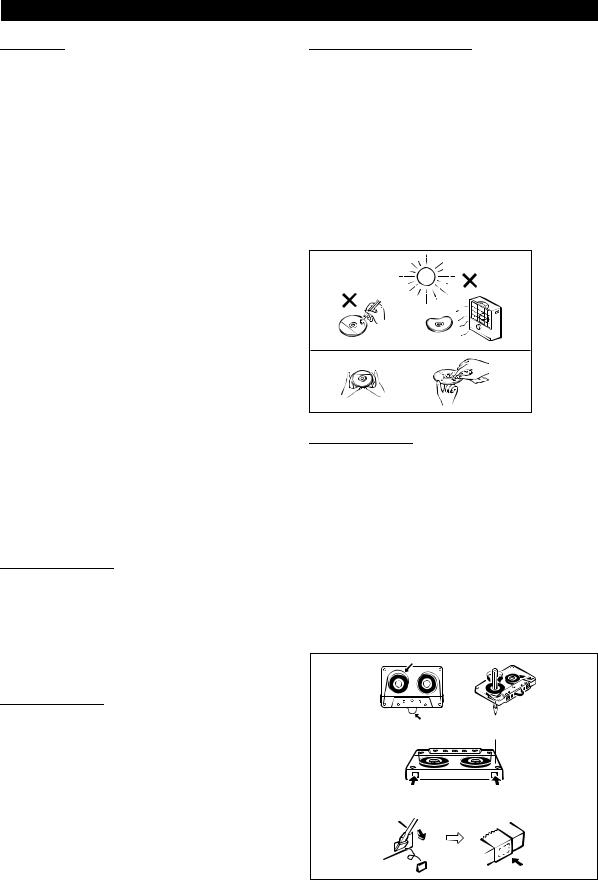
PRECAUTIONS
■ General
●Do not use oil, solvents, gasoline, paint thinners or insecticides on the unit.
●Do not expose the unit to moisture, to temperatures higher than 140˚F (60˚C) or to extreme low temperatures.
●Keep the unit away from direct sunlight, strong magnetic fields, excessive dust, humidity and electronic/electrical equipment (home computers, facsimiles, etc.) which generates electrical noise.
●Hold the AC power plug by the head when removing it from the AC outlet, as pulling the cord can damage internal wires.
●When cleaning the heads, pinch rollers, etc, remove the AC power plug from the AC outlet as the unit contains high voltages.
Do not remove the outer cover, as this may result in electric shock. Refer internal service to your local SHARP service facility.
●Use the unit on a firm, level surface free from vibration, and do not place anything on the top of the unit.
●If the unit does not work properly while in use, disconnect the AC power cord from the AC outlet. Plug the AC power cord back in, and then press the ON/STAND-BY button to turn the power on.
●If an electrical storm is taking place near you, it is suggested that you disconnect the AC power cord from the AC outlet for safety.
Warning:
The voltage used must be the same as that specified on this unit. Using this product with a higher voltage other than which is specified is dangerous and may result in a fire or other type of accident causing damage. SHARP will not be held responsible for any damage resulting from use of this unit with a voltage other than that which is specified.
■ Volume control
The sound level at a given volume setting depends on a combination of speaker efficiency, location and various other factors.
It is advisable to avoid exposure to high volume levels, which occur while turning the unit on with the volume control setting up high, or while continually listening at high volumes.
■ Care of compact discs
Compact discs are fairly resistant to damage, however mistracking can occur due to an accumulation of dirt on the disc surface.
Follow the guidelines below for maximum enjoyment from your CD collection and player.
●Do not write on either side of the disc, particularly the non-label side. Signals are read from the non-label side. Do not mark this surface.
●Keep your discs away from direct sunlight, heat, and excessive moisture.
●Always hold the CDs by the edges. Fingerprints, dirt, or water on the CDs can cause noise or mistracking. If a CD is dirty or does not play properly, clean it with a soft, dry cloth, wiping straight out from the center, along the radius.
NO
YES
Correct
■ Cassette tape
●For playback, use normal or low-noise tape for the best sound. (Metal or CrO2 tape is not recommended.)
For recording, use only normal tape.
●Do not use C-120 tapes, tapes with large diameter reels, or poor-quality tapes, as they may cause malfunctions.
●Before loading a tape into the cassette compartment, tighten the slack with a pen or pencil.
●Cassettes have removable tabs which prevent accidental recording or erasing from taking place. Removing the tab will protect the corresponding side from being erased.
Cover the tab holes with adhesive tape to erase or record again.
●TAPE 1: Playback only. TAPE 2: Playback or record.
■ Condensation
Sudden temperature changes, storage or operation in an extremely humid environment may cause condensation inside the cabinet (CD pickup, tape heads, etc.) or on the transmitter LED on the remote control.
Condensation can cause the unit to malfunction.
If this happens, leave the power on with no disc (or cassette) in the unit until normal playback is possible (about 1 hour). Wipe off any condensation on the transmitter LED with a soft cloth before operating the unit.
Side A (1)
Tab for side B (2) |
Tab for side A (1) |
2
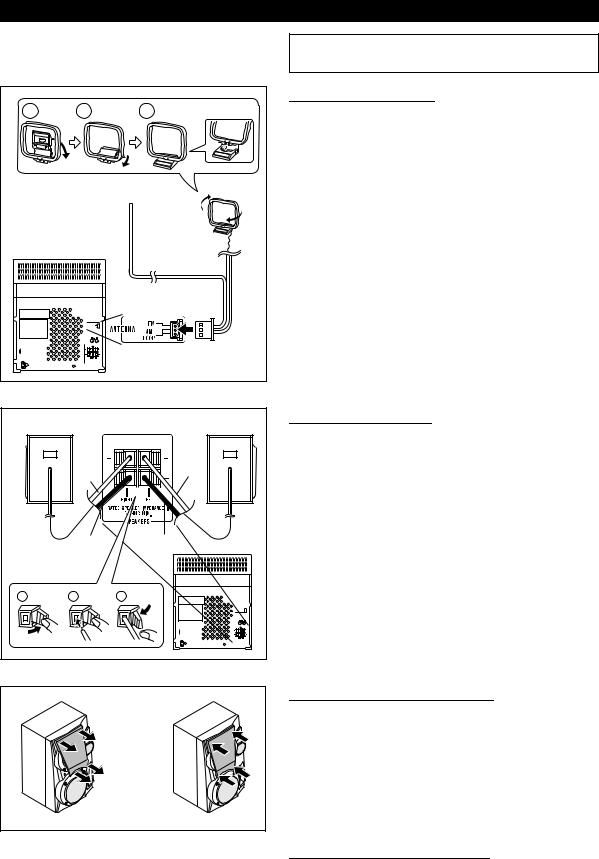
PREPARATION FOR USE
1 |
2 |
3 |
|
FM antenna |
AM loop |
|
antenna |
|
|
|
Right speaker |
Left speaker |
|
|
Red |
Red |
|
|
|
|
Black |
Black |
1 |
2 |
3 |
●Unplug the AC power cord from the AC outlet before connecting or disconnecting any component.
■Antenna connection
Connect the antenna wire to the ANTENNA jack.
FM antenna
Position the FM antenna wire in the direction where the strongest signal can be received.
AM loop antenna
Position the AM loop antenna for optimum reception.
Place the AM loop antenna on a shelf, etc., or attach it to a stand or wall with screws (not supplied).
Notes:
●Do not place the antenna on the main unit as it may result in noise pickup from the internal digital electronics.
Place the antenna away from the unit for better reception.
●If the AM loop antenna and the FM antenna wire are placed near the AC power cord, interference may result.
●Do not connect the attached FM antenna to an outdoor FM antenna. Otherwise, trouble may occur.
■ Speaker connection
Connect each speaker wire to the SPEAKER terminals as shown.
Use speakers with an impedance of 6 ohms or more, as lower impedance speakers can damage the unit.
●Connect the black wire to the minus (−) terminal, and the red wire to the plus (+) terminal.
Caution:
●Do not mistake the right channel for the left channel when connecting the speakers to the unit.
The right speaker is the one on the right side when you are facing the front of the unit.
●Do not let the bare speaker wires touch each other as this may damage the amplifier and/or speakers.
●Do not allow any objects to fall into or to be placed in the bass reflex ducts.
●Do not stand or sit on the speakers. If the speakers fall or collapse, you may be injured.
■ Removing the speaker grilles
1 Remove the lower part of the speaker grille first.
2 Remove the upper part of the speaker grille.
● Only the grills on the upper woofers are removable.
Caution:
When the speaker grilles are removed, the speaker diaphragms are exposed. Make sure nothing comes into contact with the speaker diaphragms.
■ Mounting the speaker grilles
Fit the four posts on the speaker grille into the mounting holes and push them lightly with the palm of your hand to secure.
3
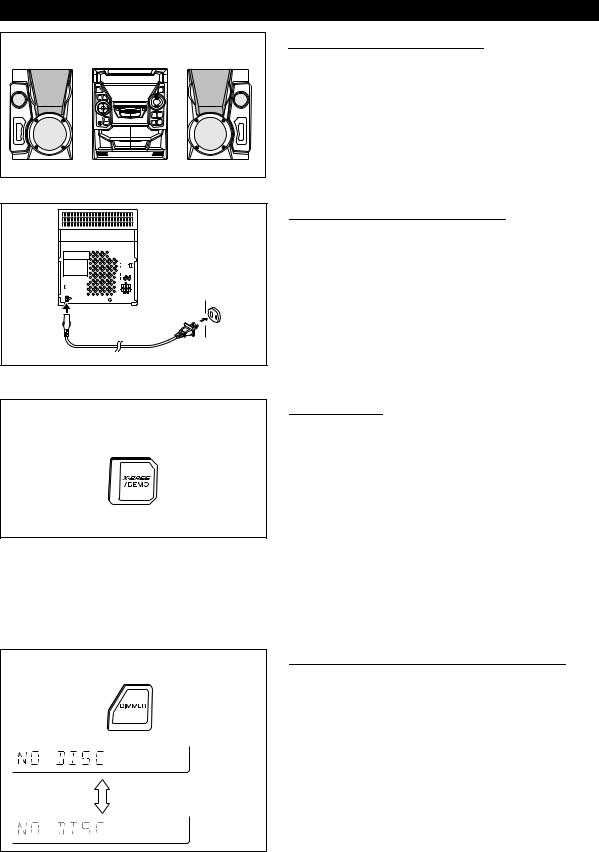
(Continued) |
|
|
■ Placing the speaker system |
Left speaker |
Right speaker |
|
The left and right speakers have individual shapes. For best per- |
|
formance, place the speakers according to the diagram to the |
|
left. |
To an AC outlet
AC 120 V, 60 Hz
To AC INPUT
■ Connecting the AC power cord
Connect the AC power cord to the AC INPUT jack, then connect the AC power cord plug to an AC outlet.
Notes:
●Unplug the AC power cord from the AC outlet if the unit will not be in used for a prolonged period of time.
●Never use a power cord other than the one supplied. Use of a power cord other than the one supplied may cause an electric shock or fire.
(Main unit operation)
(Main unit operation)
When bright
When dark
■ Demo mode
When the AC power cord is first connected, the unit will enter the demonstration mode.
To cancel the demonstration mode:
When the unit is in the stand-by mode (demonstration mode), press the X-BASS/DEMO button.
●The demonstration mode will be canceled, the display will disappear.
To return to the demonstration mode:
When the unit is in the stand-by mode, press the X-BASS/DEMO button again.
Note:
●When the power is on, the X-BASS/DEMO button can be used to select the extra bass mode.
■To change the brightness of the display
Press the DIMMER button.
● The display will be made dimmer.
To return to the original brightness:
Press the DIMMER button again.
4
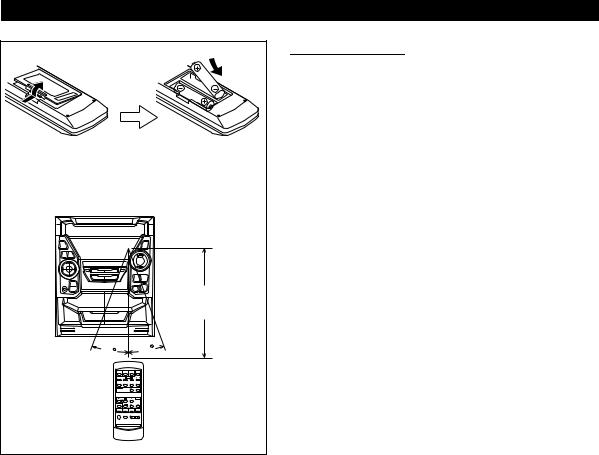
(Continued)
●2 "AA" size batteries (UM/SUM-3, R6, HP-7 or similar)
●Batteries are not included.
8" - 20'
(0.2 m - 6 m)
15 |
15 |
■ Remote control
●When inserting or removing the batteries, push them toward the ë battery terminals.
●Installing the batteries incorrectly may cause the unit to malfunction.
Precautions for battery use:
●Insert the batteries according to the direction indicated in the battery compartment.
●Replace all old batteries with new ones at the same time.
●Do not mix old and new batteries.
●Remove the batteries if they are weak or if the unit will not be used for long periods of time. This will prevent potential damage due to battery leakage.
Caution:
Do not use rechargeable batteries (nickel-cadmium battery, etc.).
Notes concerning use:
●Replace the batteries if the operating distance is reduced or if the operation becomes erratic.
●Periodically clean the transmitter LED on the remote control and the sensor on the main unit with a soft cloth.
●Exposing the sensor on the main unit to strong light may interfere with operation. Change the lighting or the direction of the unit.
●Keep the remote control away from moisture, excessive heat, shock, and vibrations.
5
